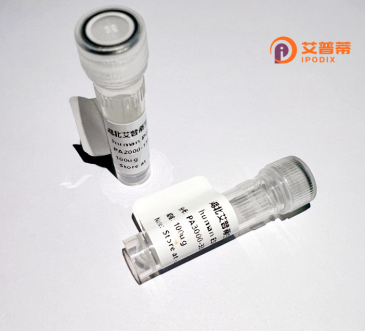
| 纯度 | >90%SDS-PAGE. |
| 种属 | Human |
| 靶点 | SOS1 |
| Uniprot No | Q07889 |
| 内毒素 | < 0.01EU/μg |
| 表达宿主 | E.coli |
| 表达区间 | 1-313-420 aa |
| 活性数据 | SQLSKPGAALYLQSIGEGFKEAVQYVLPRLLLAPVYHCLHYFELLKQLEEKSEDQEDKECLKQAITALLNVQSGMEKICSKSLAKRRLSESACRFYSQQMKGKQLAIK |
| 分子量 | 37.62 kDa |
| 蛋白标签 | GST-tag at N-terminal |
| 缓冲液 | PBS, pH7.4, containing 0.01% SKL, 1mM DTT, 5% Trehalose and Proclin300. |
| 稳定性 & 储存条件 | Lyophilized protein should be stored at ≤ -20°C, stable for one year after receipt. Reconstituted protein solution can be stored at 2-8°C for 2-7 days. Aliquots of reconstituted samples are stable at ≤ -20°C for 3 months. |
| 复溶 | Always centrifuge tubes before opening.Do not mix by vortex or pipetting. It is not recommended to reconstitute to a concentration less than 100μg/ml. Dissolve the lyophilized protein in distilled water. Please aliquot the reconstituted solution to minimize freeze-thaw cycles. |
以下是3篇关于重组人SOS1蛋白的代表性文献,基于近年的研究进展整理:
---
1. **文献名称**:*"The structural basis of Ras activation by the exchange factor SOS1"*
**作者**:Boriack-Sjodin PA, Margarit SM, Bar-Sagi D, Kuriyan J.
**摘要**:解析了SOS1与Ras蛋白复合物的晶体结构,揭示了SOS1通过催化结构域促进Ras的GTP/GDP交换机制,并发现致癌突变(如SOS1-E2K)导致其持续性激活的分子基础。
2. **文献名称**:*"PH domain of SOS1 regulates spatiotemporal activation of Ras and Cdc42"*
**作者**:Jeng HH, Taylor LJ, Bar-Sagi D.
**摘要**:通过重组SOS1蛋白实验,证明其PH结构域(pleckstrin homology domain)通过膜定位调控Ras和Cdc42的时空激活,影响细胞迁移和增殖。
3. **文献名称**:*"Allosteric inhibition of SOS1 prevents oncogenic RAS signaling"*
**作者**:Mishra AK, Cesar-Razquin A, Niederacher G, et al.
**摘要**:利用重组SOS1蛋白筛选小分子抑制剂,发现靶向其催化结构域变构位点的化合物可阻断RAS信号传导,为KRAS突变癌症提供潜在治疗策略。
---
**说明**:SOS1在RAS-MAPK信号通路中起核心调控作用,重组SOS1蛋白多用于结构生物学(如冷冻电镜/晶体学研究)、信号机制探索(如突变功能验证)及药物开发平台搭建。最新研究(如2023年《Nature》)还关注其变构调节机制和疾病相关突变的功能重塑。
SOS1 (Son of Sevenless homolog 1) is a pivotal Ras guanine nucleotide exchange factor (GEF) that plays a critical role in regulating cellular signal transduction pathways. It functions as a molecular bridge connecting receptor tyrosine kinases (RTKs) to the activation of Ras GTPases (e.g., KRAS, NRAS, HRAS), which control cell proliferation, differentiation, and survival. Structurally, SOS1 contains a catalytic RasGEF domain, a CDC25 homology domain responsible for nucleotide exchange, and regulatory domains such as the PH (pleckstrin homology) domain and Grb2-binding sites. Its activity is tightly regulated through autoinhibitory intramolecular interactions and phosphorylation events. Dysregulation of SOS1 is implicated in cancer, Noonan syndrome, and other RASopathies.
Recombinant human SOS1 protein is engineered using heterologous expression systems (e.g., bacteria, insect, or mammalian cells) to study its biochemical activity, interactions with Ras, and responses to upstream signals like EGFR activation. Purified SOS1 serves as a tool for drug discovery, particularly targeting RAS-driven cancers, where SOS1 inhibitors are explored to disrupt oncogenic Ras signaling. Its role in modulating MAPK/ERK pathways also makes it relevant for therapeutic interventions. Recombinant SOS1 is essential for in vitro studies, structural analyses (e.g., X-ray crystallography), and high-throughput screening to identify modulators of Ras activation.
×